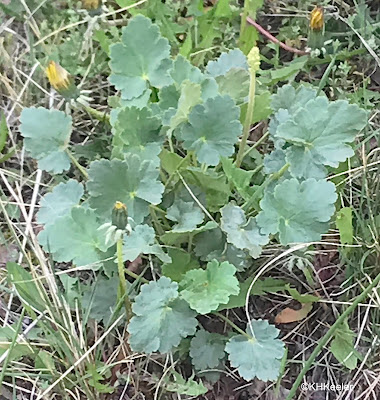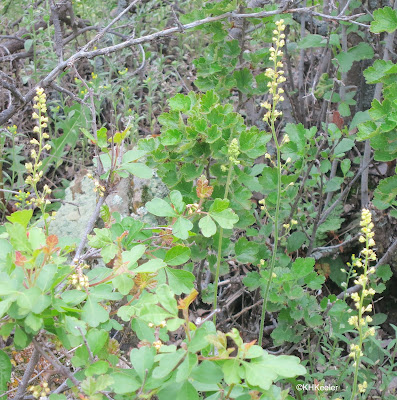The coralbells or alumroots, Heuchera species, are a genus of 37 species in the saxifrage family Saxifragaceae. They are endemic to (native to and only found in) North America, at least one species native to every state but Florida. Some have really small ranges, within a single state or part of a state (see USDA map link). Mostly the wild ones are called alumroots, while the larger species, several of which have been domesticated as garden plants, are called coralbells.
 |
| common alumroot, Heuchera parvifolia the flower stalk is still expanding (those are dandelion buds hiding among the alumroot leaves) |
Common alumroot, Heuchera parvifolia, growing near me in the Rocky Mountain foothills, has the fourth-largest range, all across the interior western US. It prefers rocky areas, but can also be found in meadows and sometimes out into sagebrush and pinyon-juniper forests. While it flowers from May to August, often it is among the first group of plants to flower, at least in northern Colorado. The flowers are small and yellow, on both sides of a stalk; I'd call them more interesting than showy. But it is always great to see them.
 |
| common alumroot, Heuchera parvifolia (Lots of leaves of another species, three-leaf sumac on the lower left). |
I personally like alumroots because in my botany education, I heard a lot about plants in the saxifrage family (perhaps because British botanists worked out basic principles with them), but I could not think of any that I had seen. So alumroots represent a plant family I wanted to get to know and I paid attention when I saw one. Wild alumroots look a lot like coralbells from the garden, which these days are complex hybrids between species, so to learn one makes it easy to recognize the others.
Saxifragaceae, the family name, is based on Saxifrage, a European species, and is a Latin compound meaning "rock-breaker." Members of the family, including alumroots, often grow in crevasses in rocks, as if they broke the rock. Heuchera was named to honor a German botanist, Johann Heinrich von Heucher (1677-1747). The widespread species I mention in this post are Heuchera parvifolia, parvi- is small in Latin, folia, leaves, so "small-leaved", H. parviflora, which, since flora = flowers, is small-flowered, and H. micrantha. The word micrantha is a form of the Latin word micranthus, meaning small-flowered. The two used in dyeing (see below) are Heuchera bracteata, the bracted alumroot, bracts being small leaves surrounding the flower and H. cylindrica, poker alumroot, or cylindrical alumroot, referring to its shape. Botanists reach for some distinctive characteristic in creating the scientific name, but in groups like alumroots that look quite similar, the distinctions can be subtle.
Cultivated alumroots are generally called coralbells. That name immediately reminded me of the children's song, which I knew as
White coralbells, upon a slender stalk,Lilies-of-the-valley deck my garden walk.
Oh don't you wish, that you might hear them ring?
That will happen only when the fairies sing.
Folksong sources say this appears to be a genuine North American folksong, from the 19th century or earlier, origin unknown. Which fits if coralbells are North American endemics.
But if you google coralbells, you mainly find red-flowered plants. What? That is consistent with coral, since coral jewelry is mostly orange or pinkish orange. So what was the song-writer thinking? I looked for another plant named coralbells but couldn't find any. Since coralbells, Heuchera, are native only to North America, there wouldn't be an old old European name for this plant, though someone could have taken the name from another plant. But there was no sign of that; the only coralbells on Google or in my European flower books is Heuchera. So I looked for alumroots with white flowers. Wow, look at this photo from the Lady Bird Johnson Wildflower Center link. This is smallflower alumroot, Heuchera parviflora, native across the eastern US. Other pictures of it show the flowers as yellow. Other species, for example American alumroot, Heuchera americana, and mountain saxifrage, from the West, Heuchera micrantha, also show sprays of white flowers. And, note that many corals, the sea animals, produce white skeletons, especially when sold in shell shops. Possibly the writer of the folksong and the people who named the plant might have seen both white alumroot flowers and white corals.
 |
| coralbells planted for its colored leaves, hybrid Heuchera |
The alumroot name is equally interesting. There are plants that concentrate metals and alum is a common short form of aluminum or a term for aluminum salts. Usually metal-rich plants do it by taking up the metal from the soil and then never excreting it, leaving the plant is rich in aluminum or iron or lead. But when I looked at lists of aluminum-containing plants, alumroot was not on the list. So why is it called alumroot if there is no alum in the root? What is in alumroot's roots are tannins, astringent compounds which bind to proteins. When settlers tried to dye cloth using leaves or roots found in North America, they needed a mordant, a metal ion to link the color to the cloth. Typical mordants were iron salts and aluminum salts. But tannins also work. The settlers discovered that if they put alumroot plant roots into the dye bath, they acted as a mordant, greatly improving the dyeing. So settlers called the plants alumroot, not because it had alum, but because, in dyeing, it worked like alum. We stopped home dyeing more than 150 years ago, when aniline dyes were discovered (link), but we still call the plants alumroots.
 |
| common alumroot, Heuchera parvifolia |
The alumroots were widely used by Native Americans as medicines. Usually, as you might guess, the roots were used. The tannins make them quite astringent and antiseptic. Treatments included to bring down fevers, soothe sore throats, and wash sore eyes. They are styptic and will help close wounds and stop bleeding. The list is long and varies with tribe and species of alumroot. See Moerman Native American Ethnobotany online link. All indications are that these are effective herbal remedies that deserve wider recognition.
 |
| common alumroot, Heuchera parvifolia |
 |
| common alumroot, Heuchera parvifolia |
References
Missouri Plant Finder. Heuchera. Missouri Botanic Garden. link. Accessed 2/26/21.
Moerman, D. E. 1998. Native American ethnobotany. Timber Press, Portland, OR.
Waltz, R. B. and D. G. Engle. 2021. White coral bells. The Ballad Index link
Kathy Keeler, A Wandering Botanist
More at awanderingbotanist.com
Join me on Facebook: https://www.facebook.com/AWanderingBotanist
Very interesting post. I remember White Coralbells from summer camp. Did you sing it as a round? We did :)
ReplyDelete